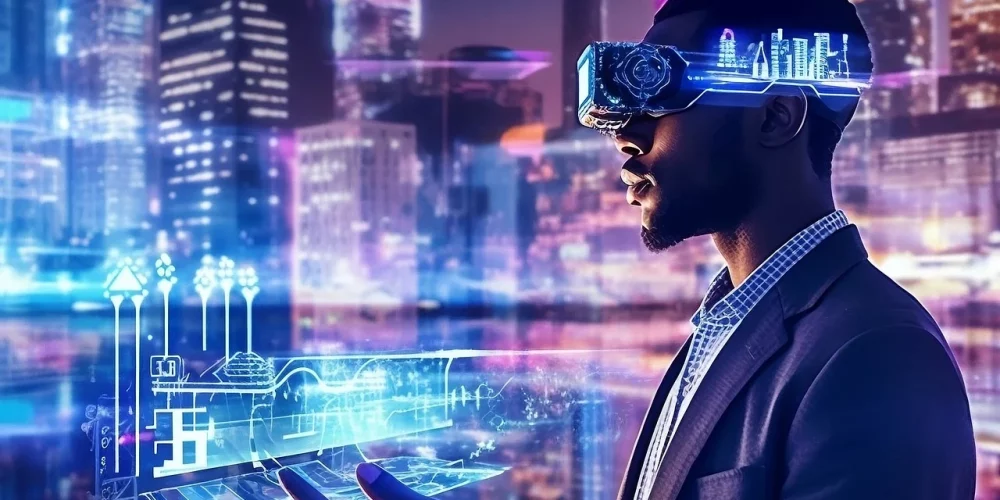Augmented Reality (AR) and Virtual Reality (VR) are immersive technologies that have made significant strides in the last decade. They offer unique experiences in fields ranging from entertainment to healthcare, education, and beyond. While similar to VR, AR does not completely replace the user’s real-world view with a simulated one. Instead, it adds information or enhances the existing environment. AR overlays digital content onto the real-world environment (like images, videos).
Augmented Reality (AR) and Virtual Reality (VR) are immersive technologies that have made significant strides in the last decade. They offer unique experiences in fields ranging from entertainment to healthcare, education, and beyond. While similar to VR, AR does not completely replace the user’s real-world view with a simulated one. Instead, it adds information or enhances the existing environment. AR overlays digital content onto the real-world environment (like images, videos). Users typically view the augmented content through a smartphone, tablet, smart glasses, or a heads-up display. AR and VR are still in their early stages of development, but they have the potential to revolutionize the way we interact with the world around us. As these technologies become more mature, we can expect to see them used in a wide range of new and innovative ways.
AR and VR have a wide range of potential applications, including:
Entertainment: AR and VR can be used to create immersive and engaging entertainment experiences. For example, AR can be used to add virtual characters or objects to the real world, while VR can be used to create completely virtual worlds.
Education and Training: AR and VR can be used to create realistic and engaging learning experiences. For example, AR can be used to overlay virtual diagrams or instructions on real-world objects, while VR can be used to create simulations of real-world environments.
Healthcare: AR and VR can be used to provide patients with more engaging and effective care. For example, AR can be used to help patients visualize their anatomy or to provide them with instructions on how to perform exercises, while VR can be used to help patients with anxiety or phobias.
Business: AR and VR can be used to improve communication and collaboration. For example, AR can be used to create virtual meeting rooms, while VR can be used to allow remote workers to collaborate on projects.
Key differences between the two are as follows:
Interaction with Reality: AR adds to reality, while VR replaces it.
Hardware: AR devices are generally more lightweight and transparent, allowing users to see the real world. VR devices are opaque, immersing users in a digital environment.
Portability: AR devices (especially smartphone-based AR) are typically more portable than VR setups.
Augmented Reality (AR)
Augmented Reality (AR) enhances the real-world experience by providing additional information, graphics, or interactive elements that are contextually relevant. For example, AR can display navigation directions on a smartphone screen or provide information about landmarks when viewing them through AR glasses. AR is used in a wide range of applications, including gaming (e.g., Pokémon GO), navigation, education, maintenance and repair tasks, marketing, and industrial applications like remote assistance. AR can be interactive, allowing users to interact with digital objects overlaid on the real world. This interaction can be through touch gestures, voice commands, or other input methods. AR also allows users to remain connected to their physical surroundings, making it suitable for scenarios where awareness of the real world is important.
Applications include the following:
Gaming: Pokémon GO is a popular AR game.
Retail: Try-before-you-buy experiences, like seeing how furniture looks in a room.
Navigation: Overlaying direction arrows on the real world.
Education: Interactive 3D models for better understanding of complex concepts.
Medical: Assisting surgeons with overlays during surgeries.
Challenges: AR faces challenges related to hardware, as creating seamless and lightweight AR devices with accurate tracking and natural user interfaces can be technically demanding.

Virtual reality (VR)
Virtual reality (VR) is a computer technology that simulates a three-dimensional environment, which can be explored and interacted with by a person. VR environments are typically displayed through a headset or goggles, which block out the user’s view of the real world. VR immerses the user in a fully artificial digital environment, isolating them from the real world. Devices include headsets such as Oculus Rift, HTC Vive, and PlayStation VR. VR creates a fully immersive digital environment that completely replaces the real world. Users typically wear a VR headset that covers their entire field of vision, cutting them off from the physical world. VR isolates users from the physical environment, relying heavily on visual and auditory senses. It can include 3D graphics, surround sound, and even haptic feedback to simulate touch. VR is often used for gaming, training simulations, medical therapy, architectural design, and other applications where a fully immersive and controlled environment is beneficial. VR environments can also be interactive, allowing users to move around and interact with objects or characters within the virtual space.
Applications include the following:
Gaming: Providing fully immersive gaming experiences.
Real Estate: Virtual property tours.
Training & Simulation: Training pilots, doctors, or soldiers in a risk-free environment.
Therapy: Treating PTSD or phobias using controlled simulations.
Entertainment: Virtual cinemas and concerts.
Challenges
VR can induce motion sickness or disorientation in some users due to the sensory disconnect between the virtual and real worlds. High-quality VR experiences often require powerful hardware. Hardware Limitations: High-quality VR, in particular, requires powerful hardware. Motion Sickness: Some VR users experience dizziness or nausea. Content Creation: High-quality content for AR and VR can be time-consuming and expensive to produce. Adoption Rate: While interest is growing, AR and VR are not yet mainstream technologies.
Future Prospects
Mixed Reality (MR): Combines elements of both AR and VR, where digital and real-world objects can interact. Devices like the Microsoft HoloLens are pushing the boundaries of MR.
Better Hardware: Future devices will be more lightweight, powerful, and affordable.
Social VR: Platforms like Facebook’s Horizon Workrooms aim to make VR a space not just for gaming or simulations but for social interaction and work.
Integration with AI: Combining AI with AR and VR can lead to smarter, context-aware experiences. For instance, AR glasses might recognize objects in the real world and provide contextual information instantly.
In summary, VR creates a fully immersive digital environment, while AR enhances the real world by adding digital elements to it. Both technologies have diverse applications and are continually evolving, with potential for growth in various industries such as entertainment, education, healthcare, and enterprise solutions. The choice between AR and VR depends on the specific use case and the desired level of immersion and interaction. Both AR and VR are at the intersection of technology and creativity, offering potential that’s limited only by imagination. As the technology matures and becomes more accessible, we can expect even more transformative experiences and applications in various fields.


